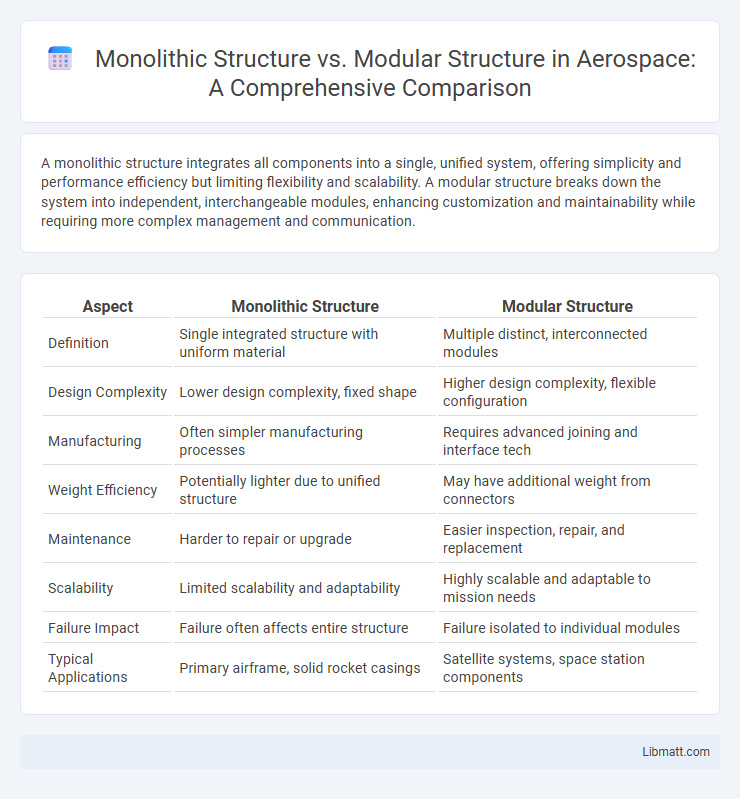A monolithic structure integrates all components into a single, unified system, offering simplicity and performance efficiency but limiting flexibility and scalability. A modular structure breaks down the system into independent, interchangeable modules, enhancing customization and maintainability while requiring more complex management and communication.
Table of Comparison
| Aspect | Monolithic Structure | Modular Structure |
|---|---|---|
| Definition | Single integrated structure with uniform material | Multiple distinct, interconnected modules |
| Design Complexity | Lower design complexity, fixed shape | Higher design complexity, flexible configuration |
| Manufacturing | Often simpler manufacturing processes | Requires advanced joining and interface tech |
| Weight Efficiency | Potentially lighter due to unified structure | May have additional weight from connectors |
| Maintenance | Harder to repair or upgrade | Easier inspection, repair, and replacement |
| Scalability | Limited scalability and adaptability | Highly scalable and adaptable to mission needs |
| Failure Impact | Failure often affects entire structure | Failure isolated to individual modules |
| Typical Applications | Primary airframe, solid rocket casings | Satellite systems, space station components |
Introduction to Structural Systems
Monolithic structures are built as a single, unified entity, offering high strength and stability with minimal joints or weak points, ideal for load-bearing walls and foundations. Modular structures consist of prefabricated, standardized units assembled onsite, providing flexibility, faster construction times, and ease of maintenance or expansion. Your choice between these structural systems depends on project requirements, cost efficiency, and desired scalability.
Defining Monolithic Structures
Monolithic structures represent a unified, single-tier software architecture where all components are interconnected and deployed as one entity. This design centralizes code, resulting in easier development and testing initially but can lead to scalability and maintenance challenges as complexity grows. Monolithic systems often feature tightly coupled modules, making updates and scaling less flexible compared to modular counterparts.
Understanding Modular Structures
Modular structures break down systems into independent, self-contained units that enhance flexibility and scalability. Each module operates semi-independently, enabling easier maintenance, testing, and updates without impacting the entire system. This architecture supports parallel development and accelerates innovation by isolating functionality into distinct components.
Key Differences Between Monolithic and Modular Structures
Monolithic structures consist of a single, unified codebase where all components are tightly integrated, making scalability and maintenance more challenging as the system grows. Modular structures break down the application into independent, interchangeable modules, enhancing flexibility, ease of updates, and parallel development. Your choice between monolithic and modular structures impacts deployment speed, fault isolation, and the ability to incorporate new features efficiently.
Construction Process Comparison
The construction process of a monolithic structure involves continuous pouring of concrete into a single formwork, resulting in a seamless and solid framework that enhances durability and reduces joints. In contrast, modular structures are built off-site in individual modules, allowing faster assembly on-site and improved quality control due to factory conditions. Your choice between these methods can impact project timeline, labor costs, and flexibility for future modifications.
Advantages of Monolithic Structures
Monolithic structures offer significant advantages such as enhanced performance due to tightly integrated components and reduced communication overhead. They simplify deployment processes by bundling all functionalities into a single executable, facilitating easier version control and testing. This structure also streamlines development in smaller teams by reducing the complexity associated with managing multiple modules or services.
Benefits of Modular Structures
Modular structures offer enhanced flexibility and scalability by allowing individual components to be developed, tested, and updated independently, reducing downtime and accelerating delivery times. This approach improves maintainability and fault isolation, as defects can be localized to specific modules without impacting the entire system. Your development process becomes more efficient, enabling easier collaboration and adaptation to changing requirements.
Challenges and Limitations
Monolithic structures often face challenges such as limited scalability, difficulty in managing complex codebases, and slower deployment cycles due to tightly coupled components. Modular structures present limitations including increased initial development complexity, dependency management issues, and the need for effective communication between separate modules. Your choice between these architectures should consider how each addresses maintainability, flexibility, and team collaboration demands.
Applications and Use Cases
Monolithic structures suit applications requiring tightly integrated components with low latency, such as legacy enterprise systems and small-scale projects where simplicity and direct communication between modules are priority. Modular structures excel in large, complex applications like microservices architectures, enabling scalability, maintainability, and independent deployment of different components in cloud-native platforms and continuous integration environments. Choosing between monolithic and modular architectures depends on your application's size, complexity, and need for flexibility or rapid iteration.
Choosing the Right Structure for Your Project
Choosing the right structure for your project depends on its complexity, scalability, and maintenance needs. A monolithic structure offers simpler deployment and development cycles, ideal for smaller projects with tightly coupled components, while a modular structure enhances flexibility and scalability by encapsulating functionality into independent, interchangeable modules. Evaluate your project's future growth and update frequency to decide between the streamlined nature of monolithic architecture and the extensibility provided by modular design.
Monolithic structure vs Modular structure Infographic

 libmatt.com
libmatt.com